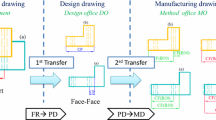Abstract
A central challenge of micro forming production is the handling of component parts. The simple transformation from macro to micro scale of the forming and handling processes is complicated due to size effects. One solution for overcoming these effects is to handle the components as linked parts as long as possible. Linked parts are manufactured in multistage processes in which every individual process generates different requirements. Therefore, arrangements have to be adopted to administrate growing amounts of data, for the documented coordination of the processes and also for a reproducible production. A practicable method is the development of product data models. Of major importance is the product data modelling based on ISO 10303, also known as Standard for the Exchange of Product Model Data (STEP). STEP offers extensive possibilities for the application-neutral and unambiguous data exchange. Using STEP a basic product data model for the micro forming technology is designed. It is focussing on the modelling of linked parts production.







Similar content being viewed by others
References
Vollertsen F (2008) Categories of size effects. Prod Eng Res Devel 2:377–383
Vollertsen F, Biermann D, Hansen HN, Jawahir IS, Kuzmann K (2009) Size effects in manufacturing of metallic components. CIRP Ann Manuf Technol 58(2):566–587
Tracht K, Weikert F (2013) Handling of micro parts. In: Vollertsen F (ed) Micro metal forming. Springer, Heidelberg
International Organization on Standardisation (ISO) (1994) ISO 10303: standard for the exchange of product model data—Industrial automation systems and integration
Geiger M, Kleiner M, Eckstein R, Tiesler N, Engel U (2001) Microforming. CIRP Ann Manufact Technol 50(2):445–462
Valente A, Carpanzano E, Nassehi A, Newman ST (2010) A STEP compliant knowledge based schema to support shop-floor adaptive automation in dynamic manufacturing environments. CIRP Ann Manuf Technol 59(1):441–444
Holland P, Standring PM, Long H, Mynors DJ (2002) Feature extraction from STEP (ISO 10303) CAD drawing files for metal forming process selection in an integrated design system. J Mater Process Technol 125–126(2002):446–455
Mahshid R, Hansen HN, Arentoft M (2014) Characterization of precision of a handling system in high performance transfer press for micro forming. CIRP Ann Manuf Technol 63(1):497–500
Fatikow S (2000) Mikroroboter und Mikromontage—Aufbau, Steuerung und Planung von flexiblen, mikroroboterbasierten Montagestationen. Teubner, Stuttgart (in German)
Wulfsberg JP, Kuhn A (2004) Work piece manipulation using standard industrial robots in the area of micro production. wt Werkstattstechnik Online 94(09):406–409 (in German)
Ellwood J, Burisch A, Schöttler K, Pokar G, Raatz A, Hesselbach J (2011) Size-adopted manipulation robots for microassembly. In: Büttgenbach S, Burisch A, Hesselbach J (eds) Manufacturing of active microsystems. Microtechnology and MEMS series. Springer, Heidelberg, pp 269–286
Vandaele V, Lambert P, Delchambre A (2005) Non-contact handling in microassembly—acoustical levitation. Precis Eng 29(4):491–505
Van Brussel H, Peirs J, Reynaerts D, Delchambre A, Reinhart G, Roth N, Weck M, Zussmann E (2000) Assembly of microsystems. CIRP Ann Manufact Technol 49(2):451–472
Tracht K, Schenck C, Weikert F, Kuhfuß B (2010) Conveyance of micro-cold-formed parts in a linkage. wt Werkstattstechnik Online 100(11/12):864–868 (in German)
Merklein M, Stellin T, Engel U (2011) Simulation of a full forward extrusion process from metal strip. In: AIP conference proceedings, vol 1353, pp 493–498
Merklein M, Stellin T, Engel U (2012) Experimental study of a full forward extrusion process from metal strip. Key Eng Mater 504–506:587–592
Kuhfuß B, Moumi E, Tracht K, Weikert F, Vollertsen F, Stephen A (2011) Process chains in microforming technology using scaling effects. In: AIP conference proceedings, vol 1353, pp 535–540
Tracht K, Weikert F, Hanke T, Kuhfuß B, Hellwig C (2011) Modeling of linked parts in micro-forming. wt Werkstattstechnik Online 101(11/12):765–769 (in German)
Tracht K, Weikert F, Kuhfuß B, Hellwig C, Schenck C (2011) Technologische und datentechnische Vernetzung von Fertigungs-einrichtungen der Mikroumformung. In: Kraft O, Haug A, Vollertsen F, Büttgenbach S (eds) Kolloquium Mikroproduktion und Abschlusskolloquium SFB 499. Karlsruhe, pp 133 138 (in German)
International Organization on Standardisation (ISO) (2004) ISO 10303-11: standard for the exchange of product model data—Industrial automation systems and integration—Product data representation and exchange. Part 11: Description methods: the EXPRESS language reference manual
International Organization on Standardisation (ISO) (2001) ISO 10303-207: standard for the exchange of product model data—Industrial automation systems and integration—Product data representation and exchange. Part 207: Application protocol: sheet metal die planning and design
Tracht K, Weikert F, Hanke T (2012) Suitability of the ISO 10303-207 standard for product modeling of line linked micro parts. In: Chryssolouris G, Mourtzis D (eds) Proceedings of the 45th international conference on manufacturing systems (CMS2012), Athens, pp 406–413
International Organization on Standardisation (ISO) (2005) ISO 10303-41: standard for the exchange of product model data—Industrial automation systems and integration—Product data representation and exchange. Part 41: Integrated generic resource: fundamentals of product description and support
Sonderforschungsbereich 747 (2015): SFB 747 “Mikrokaltumformen”—allgemeine Beschreibung. http://www.sfb747.uni-bremen.de/sfb-747-general-description/view?set_language=en. 23 Dec 2015
Acknowledgments
The authors gratefully acknowledge the financial support by Deutsche Forschungsgemeinschaft (DFG, German Research Foundation) for Subproject C5 “Teileverbunde” within the SFB 747 (Collaborative Research Center) “Mikrokaltumformen—Prozesse, Charakterisierung, Optimierung”.
Author information
Authors and Affiliations
Corresponding author
Rights and permissions
About this article
Cite this article
Weikert, F., Tracht, K. STEP product model for micro formed linked parts. Prod. Eng. Res. Devel. 10, 293–303 (2016). https://doi.org/10.1007/s11740-016-0667-6
Received:
Accepted:
Published:
Issue Date:
DOI: https://doi.org/10.1007/s11740-016-0667-6




